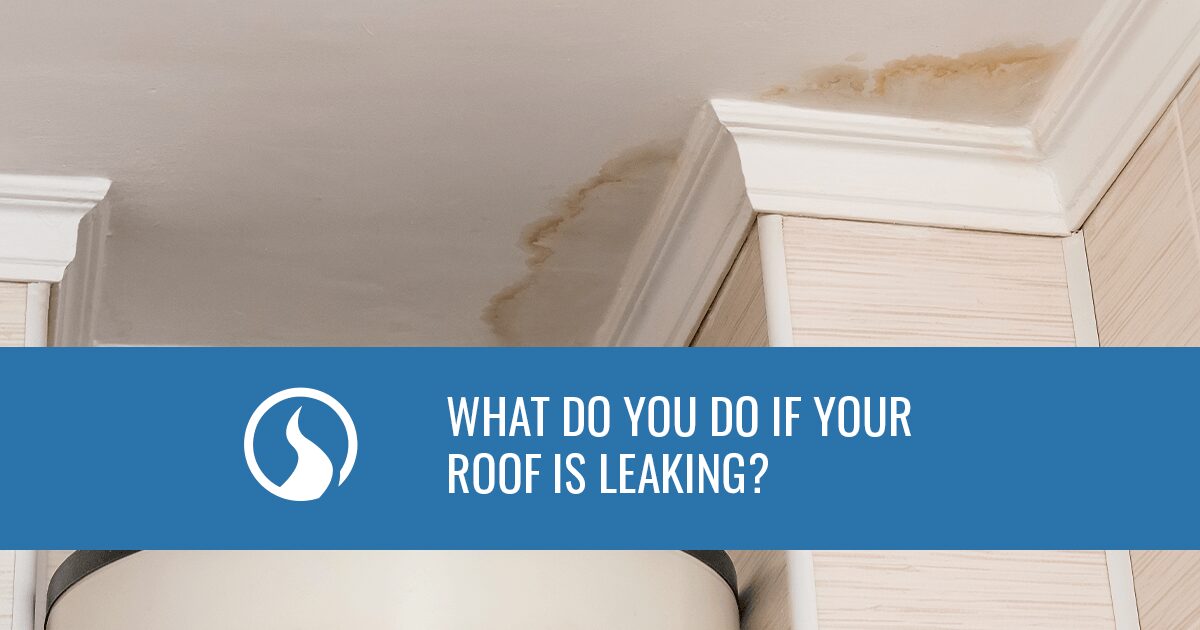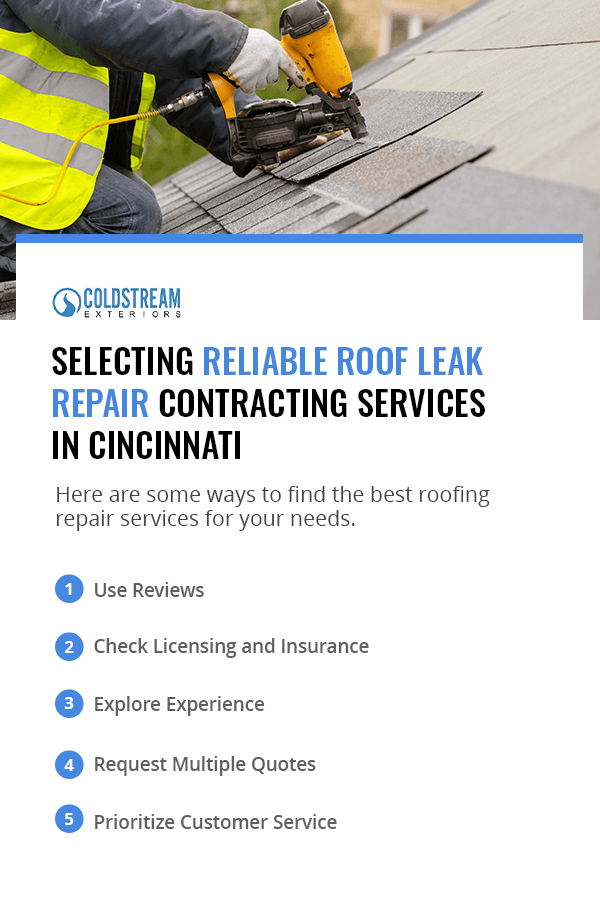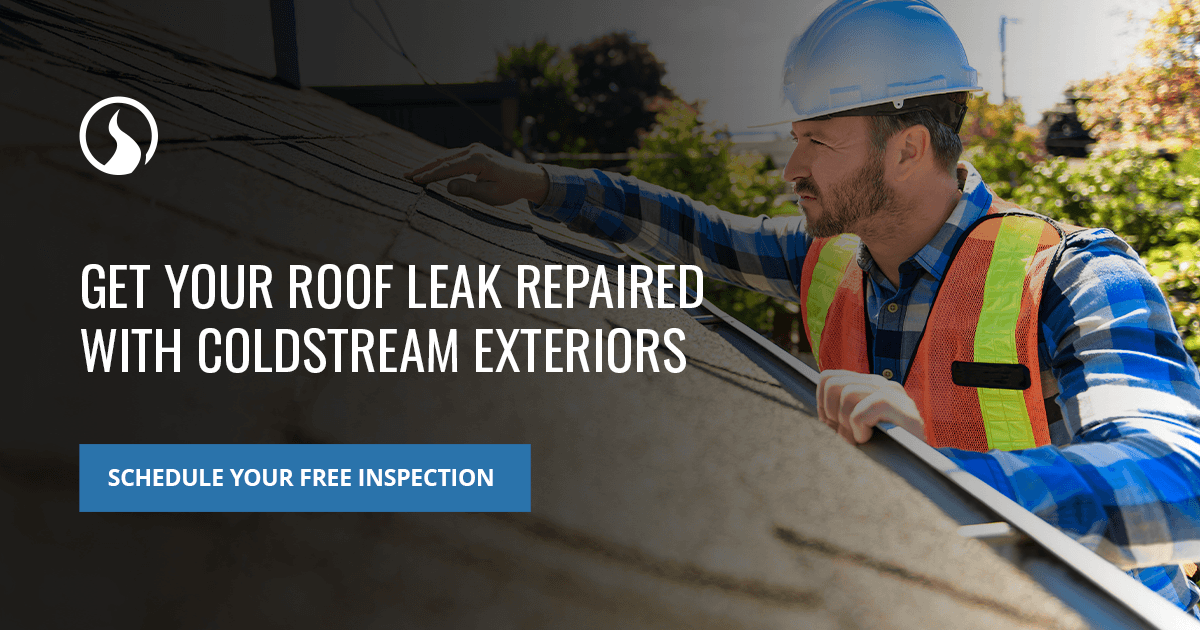
A leaking roof is the last thing many homeowners want to deal with. Once water gets inside, it can quickly start causing significant damage. While a minor leak can cost you as little as $150, major repairs can cost $1,000 and beyond. Understanding roof leaks will help you catch problems earlier, reducing repair costs.
How Do You Know if Your Roof Is Leaking?

Spotting a roof leak early will reduce the water damage, keeping your home safe. Leaks can be hard to see — knowing what to look for will help you stay prepared. Some common signs your roof is leaking include:
- Puddles or drips: Pooling water is the clearest sign of a leak. If you see water dripping from your ceiling or pooling on the floor, there’s probably a leak. Having actual water coming in means your roof needs immediate attention. You need a professional to inspect your home for serious water damage.
- Musty smells: Musty or damp smells could mean there’s a roof leak. Mold and mildew grow in wet conditions, creating that musty smell. Even if you don’t see any water, the musty smell likely means there’s water somewhere.
- Water stains: Water stains appear as brown or yellow patches on your roof and walls. They’ll grow over time as the water spreads. If you notice water stains popping up, it’s time to investigate. Try to find the source to pinpoint the leak.
- Peeling paint: Water makes your paint or wallpaper peel. When water comes in through your roof, it travels down the walls. The moisture separates the paint or wallpaper from the wall, causing bubbling, peeling or warping.
Why Is Your Roof Leaking?
Roof leaks are sneaky. Your roof is designed to keep water out, but damage and wear can let it in. Finding the root cause is essential to stopping your leak. Once you know where it’s coming from, you can take steps to repair the problem. Weather, wear and installation issues can all cause leaks. Let’s break down these potential causes to help you find your leak.
1. Weather-Related Roof Damage
Weather is a common leak culprit. Your roof is outside 24/7, taking wear from wind, water, melting snow and ice, and debris. Strong winds can damage your shingles, letting moisture inside. Storm debris can create holes or cracks in the roof. Additionally, ice dams can trap moisture against your roof, creating water backups.
All this weather wear can eventually lead to leaks. If you’ve recently experienced a storm or significant weather event and are seeing one of the signs of leaks discussed above, you may want to call a professional for an inspection. Weather might be the reason you’re seeing leaks.
2. Aging and Wear of Roofing Materials
Standard roofing materials are designed to last anywhere from 10 to 100 years and beyond. While they can last for decades, your roof will show signs of aging, and natural wear can lead to leaks. For example, asphalt roofs have a life span of about 20 years. Once they hit that point, you may see brittle, cracked or ineffective shingles. Other roofing materials will also show signs of deterioration.
If your roof is getting up there in years, your leak might be a symptom of aging. You can consider replacing your old roof with a new one to enjoy years of reinforced leak protection.
3. Poor Installation or Maintenance Issues
Roofs should be waterproof, but they’re only as good as their installation or maintenance. Improper shingle alignment or flashing creates imperfect seals, letting water inside. Additionally, you need to stay on top of regular maintenance. For example, failing to clean your gutters regularly can lead to water backups and leaks. Maintenance also involves inspecting your roof. Looking for minor issues like cracks and missing shingles helps you catch leak-causing problems early.

Immediate Steps to Take if You Suspect a Roof Leak
Discovering a roof leak can be stressful. Taking steps to contain the leak quickly prevents the water from causing further damage. Follow the water upwards to find the roof leak, and follow these tips.
Ensure a Safe Environment
Before containing your leak, look for safety issues. Is the leak near electrical outlets or wiring? If so, turn off the electricity in that area to avoid electrocution. If you have water pooling in the ceiling, avoid standing directly underneath it. Water pooling can lead to collapse, posing a risk to anyone underneath the bulge. If your leak is in the attic, move around carefully and use your flashlight to find the leak. Finally, remember that water can be slippery, and your floor could fall through if you step into the wrong area.
Take Temporary Measures to Contain the Leak
After making sure the area is safe, it’s time to contain the leak. Stopping the spread of water will control the damage. Use these steps to contain the leak:
- Use buckets: Place buckets or containers under the leak to catch water. Swap them out as they fill out to prevent water from spreading through your house.
- Cover the roof: If your roof has a hole, use a tarp. Covering the hole with a tarp keeps water, debris and critters from getting inside. Use nails or heavy objects to keep the tarp in place.
- Move furniture: Move your furniture and valuables out from under the leak. Anything that gets water on it could become water-damaged.
- Puncture the bulge: Roof leaks can cause ceiling bulges. If you know the bulge is from clean roof water and not your plumbing, you can puncture the hole to let water out. Hold a bowl under the area and carefully make a small puncture hole with a screwdriver. The water should drain out. Only do this if you feel comfortable.
When to Call a Professional for Roof Leak Repair
Once you’ve contained the leak, you can call in the experts. You need a trusted repair professional to ensure your roof is fixed correctly. Poor service will create more problems, leading to additional roofing expenses. Understanding what to look for in a roofing construction company is key to getting a good roof repair job. Call a professional if you’re dealing with these conditions:
- Significant leak: Dealing with lots of water? Contact roofing professionals. Lots of water means lots of potential for hidden damage. Experts will find the extent of the damage and catch anything you missed.
- Unknown source: If you can’t find a roof leak, you’ll need some help. Professionals have moisture meters and previous experience. They’ll know where to look for the leak so you can get it patched up.
- Challenging roof: High or steep roofs pose a safety concern. Roofing experts have the experience and safety gear to service challenging roofs. To stay safe, avoid fixing a challenging roof yourself.
- Old roof: Older roofs might have hidden weak points or other concerns, so you’ll want to hire a professional to handle an old roof leak. Older roofs often need a complete replacement, which should always be done professionally.
- Extensive damage: If you see lots of water damage, you need expert help. Sagging areas, large water stains and missing shingle patches are all signs of potential structural issues. Contact a professional immediately to keep your home safe.
Selecting Reliable Roof Leak Repair Contracting Services

Now that you know you need a roofing expert, how do you find the right one? There are many roofing companies, so you could spend hours combing through your options. Here are some ways to find the best roofing repair services for your needs.
1. Use Reviews
Talk to your friends and neighbors about their roofing experiences. Do they have anyone they can recommend? You can also look at online review platforms. What’s the company’s Better Business Bureau rating? Are there patterns in their reviews? Combining firsthand experience and online reviews gives you a look into a company’s reliability and service.
2. Check Licensing and Insurance
Before hiring any roofing company, ensure they’re licensed in Ohio. A valid license means they meet the state’s requirements for roofing work. Additionally, check their insurance. Reputable construction companies will have liability and workers’ compensation insurance. Insurance protects you from liability and also protects the roofing company while they’re on the job.
3. Explore Experience
Look for services with lots of roofing experience, particularly in your roof’s material. Professional companies are more likely to find hidden issues and fix them correctly. They’re also more likely to deliver better, longer-lasting results. Additionally, experienced roofers can recommend the best options and tips for maintaining your roof.
4. Request Multiple Quotes
Gather your top three to four companies and ask them for quotes. Going with the first roof construction company you find could mean missing out on a better deal.
When you receive your quotes, watch out for unusually low or high offers. These could be signs of poor-quality services or overpriced offerings. While you should go with services that fit your budget, remember that good-quality service comes at a cost.
5. Prioritize Customer Service
Choose a company that prioritizes customer service. You want to see clear communication, good warranties and quality support. Are they responsive to your questions? Do they try to make the experience smooth? Ask them about their materials, process and customer care. These questions will give you an idea of their approach to customer service.
Preventing Future Roof Leaks: Maintenance Tips
After you’ve fixed your roof leak, it’s time for prevention. Preventing leaks is less expensive and easier than repairing water damage. With regular care, you can extend your roof’s life and minimize your risk of leaks. Follow these maintenance tips to keep leaks from breaking through.
Regular Roof Inspections and Maintenance
Regular roof inspections and maintenance are some of the best ways to prevent leaks. Try to get your roof inspected by a professional at least once per year and after major weather events. These inspections help you catch potential problems before they become severe issues. During inspections, professionals will look for:
- Shingle damage.
- Loose flashing.
- Wear and tear.
- Leaks.
- Chimney, vent and skylight problems.
Getting a professional to inspect your roof ensures it receives a thorough inspection. Additionally, try to visually inspect your roof seasonally. Storms and heavy winds can cause roof damage. Use a ladder or stay on the ground and look for debris, broken shingles and visible water. If you spot any issues, contact a professional immediately.
Regularly maintain your roof to extend its life span. The more debris, water and vegetation on your roof, the more your risk of leaks increases. Maintenance includes:
- Cleaning gutters: Gutters drain water away from your home. When they’re backed up with leaves and debris, they can’t drain. Instead, the water will back up onto your roof under the shingles. Over time, the water could seep into your room and cause a leak or damage.
- Clearing debris: Debris from storms, trees or wind can damage your shingles. Without the protective roof layer, water will get inside. Clearing debris off your roof prevents damage and makes your roof look fresh.
- Trim nearby trees: Trees can throw debris and limbs onto the roof. Any trees right up against your house can cause roof wear and damage. Trim branches to keep trees away from your home.
- Clean vegetation: During inspections, you might see moss or algae growing on your roof. Vegetation can lift shingles, letting water in. Use power washing tools or a professional service to keep your roof clean.
- Replace missing shingles: If you feel comfortable doing so, you can replace missing shingles on your roof. Replacement closes up gaps, stopping water from getting inside.
Addressing Minor Repairs Promptly
You also need to repair minor issues quickly to prevent leaks. Loose flashing pieces or missing shingles can start letting water in, creating a leak. The longer you let damage sit on your roof, the more roof wear you’ll see. During your regular inspections, take note of any damage you see. Reseal your flashing or repair a shingle as soon as you can. If you need help with handling the repair, contact a professional. They’ll come in and repair the section correctly, preventing leaks.
You can also consider getting extra reinforcement around leak-prone areas. A professional can install additional sealant or flashing in problem areas for extra protection, which can help prevent repeat leaks in the future.
Get Your Roof Leak Repaired With Coldstream Exteriors
When it comes to protecting your home from a roof leak, you need the very best. At Coldstream Exteriors, we understand the urgency of roof repairs. That’s why we offer same- or next-day service for most roofing issues, including leaks. Our expert team uses the highest-quality materials to ensure effective, lasting repairs. Plus, you can have peace of mind with our industry-leading warranties on materials and labor.
Coldstream Exteriors believes in delivering results first. We only require payment once the job is complete. Over 95% of our jobs are completed in one day, so we get your home back in top condition quickly. With an A+ rating from the Better Business Bureau, you can count on us to keep your home safe. Contact Coldstream Exteriors for a free inspection today! See why homeowners in Greater Cincinnati and St. Louis consistently choose us for their residential roof repair needs.








